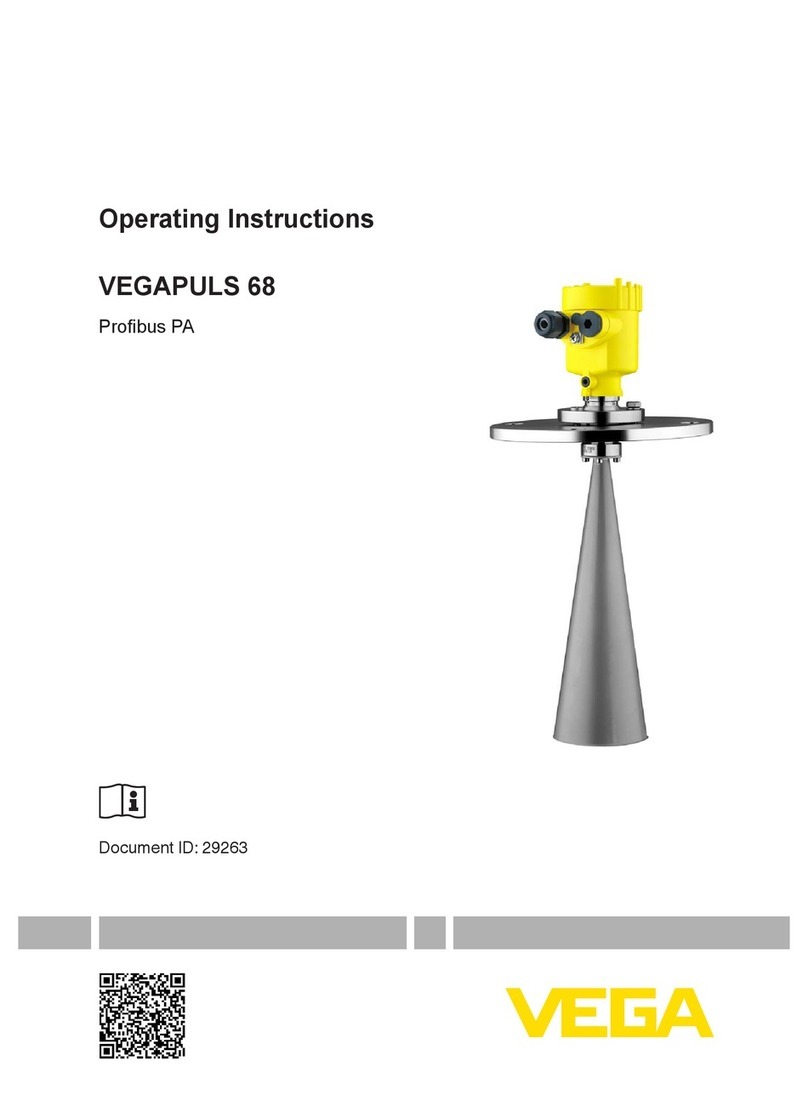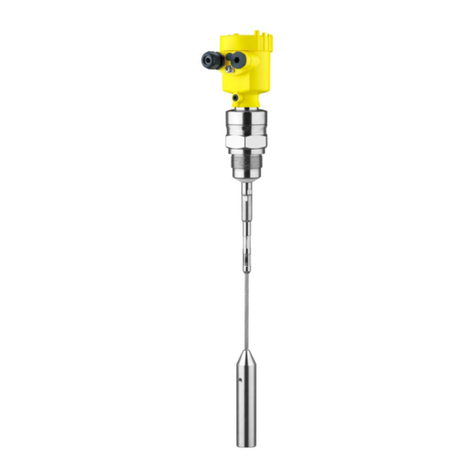Vega VEGAFLEX 86 User manual

Operating Instructions
TDR sensor for continuous level and
interface measurement of liquids
VEGAFLEX 86
Probus PA
Rod and cable probe
-196 … +280 °C
-196 … +450 °C
Document ID: 44232

2
Contents
VEGAFLEX 86 • Probus PA
44232-EN-160518
Contents
1 About this document
1.1 Function ........................................................................................................................... 4
1.2 Target group ..................................................................................................................... 4
1.3 Symbols used................................................................................................................... 4
2 For your safety
2.1 Authorised personnel ....................................................................................................... 5
2.2 Appropriate use................................................................................................................ 5
2.3 Warning about incorrect use............................................................................................. 5
2.4 General safety instructions............................................................................................... 5
2.5 CE conformity................................................................................................................... 5
2.6 NAMUR recommendations .............................................................................................. 6
2.7 Environmental instructions ............................................................................................... 6
3 Product description
3.1 Conguration.................................................................................................................... 7
3.2 Principle of operation........................................................................................................ 8
3.3 Packaging, transport and storage................................................................................... 11
3.4 Accessories and replacement parts ............................................................................... 11
4 Mounting
4.1 General instructions ....................................................................................................... 14
4.2 Mounting instructions ..................................................................................................... 15
5 Connecting to power supply
5.1 Preparing the connection ............................................................................................... 25
5.2 Connecting..................................................................................................................... 26
5.3 Wiring plan, single chamber housing.............................................................................. 27
5.4 Wiring plan, double chamber housing ............................................................................ 28
5.5 Double chamber housing with DISADAPT ..................................................................... 30
5.6 Wiring plan - version IP 66/IP 68, 1 bar........................................................................... 31
5.7 Supplementary electronics............................................................................................. 31
5.8 Set instrument address .................................................................................................. 31
5.9 Switch-on phase............................................................................................................. 32
6 Set up with the display and adjustment module
6.1 Insert display and adjustment module............................................................................ 33
6.2 Adjustment system......................................................................................................... 34
6.3 Parameter adjustment - Quick setup .............................................................................. 36
6.4 Parameter adjustment - Extended adjustment................................................................ 36
6.5 Saving the parameter adjustment data........................................................................... 54
7 Setup with PACTware
7.1 Connect the PC.............................................................................................................. 55
7.2 Parameter adjustment with PACTware............................................................................ 55
7.3 Set up with the quick setup............................................................................................. 56
7.4 Saving the parameter adjustment data........................................................................... 58
8 Set up with other systems
8.1 DD adjustment programs ............................................................................................... 59
9 Diagnostics and servicing
9.1 Maintenance .................................................................................................................. 60

3
Contents
VEGAFLEX 86 • Probus PA
44232-EN-160518
9.2 Diagnosis memory ......................................................................................................... 60
9.3 Status messages............................................................................................................ 61
9.4 Rectify faults................................................................................................................... 65
9.5 Exchanging the electronics module................................................................................ 70
9.6 Exchange or shorten cable/rod ...................................................................................... 71
9.7 Software update ............................................................................................................. 73
9.8 How to proceed if a repair is necessary.......................................................................... 73
10 Dismount
10.1 Dismounting steps.......................................................................................................... 74
10.2 Disposal ......................................................................................................................... 74
11 Supplement
11.1 Technical data ................................................................................................................ 75
11.2 Communication Probus PA........................................................................................... 87
11.3 Dimensions .................................................................................................................... 91
11.4 Industrial property rights................................................................................................. 97
11.5 Trademark ...................................................................................................................... 97
Safety instructions for Ex areas
Take note of the Ex specic safety instructions for Ex applications.
These instructions are attached as documents to each instrument
with Ex approval and are part of the operating instructions manual.
Editing status: 2016-04-13

4
1 About this document
VEGAFLEX 86 • Probus PA
44232-EN-160518
1 About this document
1.1 Function
This operating instructions manual provides all the information you
need for mounting, connection and setup as well as important instruc-
tions for maintenance and fault rectication. Please read this informa-
tion before putting the instrument into operation and keep this manual
accessible in the immediate vicinity of the device.
1.2 Target group
This operating instructions manual is directed to trained specialist
personnel. The contents of this manual should be made available to
these personnel and put into practice by them.
1.3 Symbols used
Information, tip, note
This symbol indicates helpful additional information.
Caution: If this warning is ignored, faults or malfunctions can result.
Warning: If this warning is ignored, injury to persons and/or serious
damage to the instrument can result.
Danger: If this warning is ignored, serious injury to persons and/or
destruction of the instrument can result.
Ex applications
This symbol indicates special instructions for Ex applications.
• List
The dot set in front indicates a list with no implied sequence.
→ Action
This arrow indicates a single action.
1 Sequence of actions
Numbers set in front indicate successive steps in a procedure.
Battery disposal
This symbol indicates special information about the disposal of bat-
teries and accumulators.

5
2 For your safety
VEGAFLEX 86 • Probus PA
44232-EN-160518
2 For your safety
2.1 Authorised personnel
All operations described in this operating instructions manual must
be carried out only by trained specialist personnel authorised by the
plant operator.
During work on and with the device the required personal protective
equipment must always be worn.
2.2 Appropriate use
VEGAFLEX 86 is a sensor for continuous level measurement.
You can nd detailed information about the area of application in
chapter "Product description".
Operational reliability is ensured only if the instrument is properly
used according to the specications in the operating instructions
manual as well as possible supplementary instructions.
2.3 Warning about incorrect use
Inappropriate or incorrect use of the instrument can give rise to
application-specic hazards, e.g. vessel overll or damage to system
components through incorrect mounting or adjustment. Also the pro-
tective characteristics of the instrument can be inuenced.
2.4 General safety instructions
This is a state-of-the-art instrument complying with all prevailing
regulations and guidelines. The instrument must only be operated in a
technically awless and reliable condition. The operator is responsible
for the trouble-free operation of the instrument.
During the entire duration of use, the user is obliged to determine the
compliance of the necessary occupational safety measures with the
current valid rules and regulations and also take note of new regula-
tions.
The safety instructions in this operating instructions manual, the na-
tional installation standards as well as the valid safety regulations and
accident prevention rules must be observed by the user.
For safety and warranty reasons, any invasive work on the device
beyond that described in the operating instructions manual may be
carried out only by personnel authorised by the manufacturer. Arbi-
trary conversions or modications are explicitly forbidden.
The safety approval markings and safety tips on the device must also
be observed.
2.5 CE conformity
The device fulls the legal requirements of the applicable EC guide-
lines. By axing the CE marking, we conrm successful testing of the
product.

6
2 For your safety
VEGAFLEX 86 • Probus PA
44232-EN-160518
You can nd the CE Certicate of Conformity in the download section
of our homepage.
Electromagnetic compatibility
Instruments in four-wire or Ex-d-ia version are designed for use in an
industrial environment. Nevertheless, electromagnetic interference
from electrical conductors and radiated emissions must be taken into
account, as is usual with class A instruments according to EN 61326-
1. If the instrument is used in a dierent environment, the electromag-
netic compatibility to other instruments must be ensured by suitable
measures.
2.6 NAMUR recommendations
NAMUR is the automation technology user association in the process
industry in Germany. The published NAMUR recommendations are
accepted as the standard in eld instrumentation.
The device fulls the requirements of the following NAMUR recom-
mendations:
• NE 21 – Electromagnetic compatibility of equipment
• NE 53 – Compatibility of eld devices and display/adjustment
components
• NE 107 – Self-monitoring and diagnosis of eld devices
For further information see www.namur.de.
2.7 Environmental instructions
Protection of the environment is one of our most important duties.
That is why we have introduced an environment management system
with the goal of continuously improving company environmental pro-
tection. The environment management system is certied according
to DIN EN ISO 14001.
Please help us full this obligation by observing the environmental
instructions in this manual:
• Chapter "Packaging, transport and storage"
• Chapter "Disposal"

7
3 Product description
VEGAFLEX 86 • Probus PA
44232-EN-160518
3 Product description
3.1 Conguration
The type label contains the most important data for identication and
use of the instrument:
2
1
13
14
15
16
12
11
5
3
6
4
7
8
9
10
Fig. 1: Layout of the type label (example)
1 Instrument type
2 Product code
3 Approvals
4 Power supply and signal output, electronics
5 Protection rating
6 Probe length
7 Process and ambient temperature, process pressure
8 Material, wetted parts
9 Hardware and software version
10 Order number
11 Serial number of the instrument
12 Symbol of the device protection class
13 ID numbers, instrument documentation
14 Reminder to observe the instrument documentation
15 NotiedauthorityforCEmarking
16 Approval directives
The type label contains the serial number of the instrument. With it
you can nd the following instrument data on our homepage:
• Product code (HTML)
• Delivery date (HTML)
• Order-specic instrument features (HTML)
• Operating instructions and quick setup guide at the time of ship-
ment (PDF)
• Order-specic sensor data for an electronics exchange (XML)
• Test certicate (PDF) - optional
Go to www.vega.com "VEGATools" and "Instrument search". Enter
the serial number.
Alternatively, you can access the data via your smartphone:
• Download the smartphone app "VEGATools" from the "Apple App
Store" or the "GooglePlayStore"
Type label
Serial number - Instru-
ment search

8
3 Product description
VEGAFLEX 86 • Probus PA
44232-EN-160518
• Scan the Data Matrix code on the type label of the instrument or
• Enter the serial number manually in the app
This operating instructions manual applies to the following instrument
versions:
• Hardware from 1.0.0
• Software from 1.2.0
• Only for instrument versions without SIL qualication
This electronics version can be determined via the product code on
the type label as well as on the electronics.
• Standard electronics: Type FX80PA.-
The scope of delivery encompasses:
• Sensor
• Documentation
– Quick setup guide
– Test certicate measuring accuracy (optional)
– Supplementary instructions "GSM/GPRSradiomodule"
(optional)
– Supplementary instructions manual "Heating for display and
adjustment module" (optional)
– Supplementary instructions manual "Plug connector for con-
tinuously measuring sensors" (optional)
– Ex-specic "Safety instructions" (with Ex versions)
– If necessary, further certicates
3.2 Principle of operation
The VEGAFLEX 86 is a level sensor with cable or rod probe for
continuous level or interface measurement, particularly suitable for
applications in high temperatures up to +450 °C (842 °F).
High frequency microwave pulses are guided along a steel cable or
a rod. Upon reaching the product surface, the microwave pulses are
reected. The running time is evaluated by the instrument and output-
ted as level.
Scope of this operating
instructions manual
Versions
Scope of delivery
Application area
Functional principle -
level measurement

9
3 Product description
VEGAFLEX 86 • Probus PA
44232-EN-160518
d
h
1
Fig. 2: Level measurement
1 Sensorreferenceplane(sealsurfaceoftheprocesstting)
d Distance to the level
h Height - Level
Probe end tracking
To increase sensitivity, the probe is equipped with probe end tracking.
In products with a low dielectric constant, this function is very helpful.
This is the case, for example, in plastic granules, packing chips or in
vessels with uidized products.
Between a dielectric constant of 1.5 and 3, the function switches on, if
required. As soon as the level echo can no longer be detected, probe
end tracking is automatically activated. The measurement is contin-
ued with the last calculated dielectric constant.
The accuracy thus depends on the stability of the dielectric constant.
If you measure a medium with a dielectric constant below 1.5, probe
end tracking is always active. In this case, you have to enter the
dielectric constant of the medium. A stable dielectric constant is very
important here.
High frequency microwave impulses are guided along a steel cable or
rod. Upon reaching the product surface, a part of the microwave im-
pulses is reected. The other part passes through the upper product
and is reected by the interface. The running times to the two product
layers are processed by the instrument.
Functional principle - in-
terface measurement

10
3 Product description
VEGAFLEX 86 • Probus PA
44232-EN-160518
TS
d1
h1
h2
d2
1
L2
L1
L3
Fig. 3: Interface measurement
1 Sensorreferenceplane(sealsurfaceoftheprocesstting)
d1 Distance to the interface
d2 Distance to the level
TS Thicknessoftheuppermedium(d1-d2)
h1 Height - Interface
h2 Height - Level
L1 Lower medium
L2 Upper medium
L3 Gasphase
Upper medium (L2)
• The upper medium must not be conductive
• The dielectric constant of the upper medium or the actual distance
to the interface must be known (input required). Min. dielectric con-
stant: 1.6. You can nd a list of dielectric constants on our home
page: www.vega.com.
• The composition of the upper medium must be stable, no varying
products or mixtures
• The upper medium must be homogeneous, no stratications
within the medium
• Min. thickness of the upper medium 50 mm (1.97 in)
• Clear separation from the lower medium, emulsion phase or detri-
tus layer max. 50 mm (1.97 in)
• If possible, no foam on the surface
Lower medium (L1)
• The dielectric constant must be 10 higher than the dielectric
constant of the upper medium, preferably electrically conductive.
Example: upper medium dielectric constant 2, lower medium at
least dielectric constant 12.
Gas phase (L3)
• Air or gas mixture
• Gas phase - dependent on the application, gas phase does not
always exist (d2 = 0)
Prerequisites for inter-
face measurement

11
3 Product description
VEGAFLEX 86 • Probus PA
44232-EN-160518
The instrument is always preset to the application "Level measure-
ment".
For the interface measurement, you can select the requested output
signal with the setup.
3.3 Packaging, transport and storage
Your instrument was protected by packaging during transport. Its
capacity to handle normal loads during transport is assured by a test
based on ISO 4180.
The packaging of standard instruments consists of environment-
friendly, recyclable cardboard. For special versions, PE foam or PE
foil is also used. Dispose of the packaging material via specialised
recycling companies.
Transport must be carried out in due consideration of the notes on the
transport packaging. Nonobservance of these instructions can cause
damage to the device.
The delivery must be checked for completeness and possible transit
damage immediately at receipt. Ascertained transit damage or con-
cealed defects must be appropriately dealt with.
Up to the time of installation, the packages must be left closed and
stored according to the orientation and storage markings on the
outside.
Unless otherwise indicated, the packages must be stored only under
the following conditions:
• Not in the open
• Dry and dust free
• Not exposed to corrosive media
• Protected against solar radiation
• Avoiding mechanical shock and vibration
• Storage and transport temperature see chapter "Supplement -
Technicaldata-Ambientconditions"
• Relative humidity 20 … 85 %
3.4 Accessories and replacement parts
The display and adjustment module PLICSCOM is used for measured
value indication, adjustment and diagnosis. It can be inserted into the
sensor and removed at any time.
You can nd further information in the operating instructions "Display
andadjustmentmodulePLICSCOM" (Document-ID 27835).
The interface adapter VEGACONNECT enables the connection of
communication-capable instruments to the USB interface of a PC. For
parameter adjustment of these instruments, the adjustment software
PACTware with VEGA-DTM is required.
You can nd further information in the operating instructions "Interface
adapterVEGACONNECT" (Document-ID 32628).
Output signal
Packaging
T
ransport
Transport inspection
Storage
Storage and transport
temperature
PLICSCOM
VEGACONNECT

12
3 Product description
VEGAFLEX 86 • Probus PA
44232-EN-160518
The VEGADIS 81 is an external display and adjustment unit for VEGA
plics®sensors.
For sensors with double chamber housing the interface adapter
"DISADAPT" is also required for VEGADIS 81.
You can nd further information in the operating instructions "VE-
GADIS81" (Document-ID 43814).
The adapter "DISADAPT" is an accessory part for sensors with dou-
ble chamber housings. It enables the connection of VEGADIS 81 to
the sensor housing via an M12 x 1 plug.
You can nd further information in the supplementary instructions
"AdapterDISADAPT" (Document-ID 45250).
PLICSMOBILE T61 is an external GSM/GPRS radio unit for transmis-
sion of measured values and for remote parameter adjustment of
plics® sensors. Adjustment is carried out via PACTware/DTM and the
integrated USB connection.
You can nd further information in the supplementary instructions
"PLICSMOBILET61" (Document-ID 37700).
The protective cover protects the sensor housing against soiling and
intense heat from solar radiation.
You will nd additional information in the supplementary instructions
manual "Protective cover" (Document-ID 34296).
Screwed anges are available in dierent versions according to the
following standards: DIN 2501, EN 1092-1, BS 10, ASME B 16.5,
JIS B 2210-1984, GOST 12821-80.
You can nd additional information in the supplementary instructions
manual "FlangesaccordingtoDIN-EN-ASME-JIS".
The electronics module VEGAFLEX series 80 is a replacement part
for TDR sensors of VEGAFLEX series 80. There is a dierent version
available for each type of signal output.
You can nd further information in the operating instructions manual
"ElectronicsmoduleVEGAFLEXseries80".
The display and adjustment module can be optionally replaced by a
display and adjustment module with heating function.
You can use this display and adjustment module in an ambient tem-
perature range of -40 … +70 °C.
You can nd further information in the operating instructions "Display
and adjustment module with heating" (Document-ID 31708).
If the standard sensor housing is too big or in case of strong vibra-
tions, an external housing can be used.
Then the sensor housing is made of stainless steel. The electronics is
located in the external housing which can be mounted in a distance of
up to 10 m (147 ft) to the sensor by using a connection cable.
VEGADIS 81
DISADAPT
PLICSMOBILE T61
Protective cap
Flanges
Electronics module
Display and adjustment
module with heating
External housing

13
3 Product description
VEGAFLEX 86 • Probus PA
44232-EN-160518
You can nd additional information in the operating instructions
manual "Externalhousing" (Document-ID 46802).
If you are using an instrument with rod version, you can extend the
rod probe individually with curved segments and rod and cable exten-
sions of dierent lengths.
All extensions used must not exceed a total length of 6 m (19.7 ft).
The extensions are available in the following lengths:
Rod: ø 16 mm (0.63 in)
• Basic segments: 20 … 5900 mm (0.79 … 232 in)
• Rod/cable segments: 20 … 5900 mm (0.79 … 232 in)
• Curved segments: 100 x 100 mm (3.94 … 3.94 in)
You can nd further information in the operating instructions manual
"RodandcablecomponentsVEGAFLEX80series".
The combination of a bypass tube and a VEGAFLEX 86 enables con-
tinuous level measurement outside the vessel. The bypass consists
of a standpipe which is mounted as a communicating container on
the side of the vessel via two process ttings. This kind of mounting
ensures that the level in the standpipe and the level in the vessel are
the same.
The length and the process ttings can be congured individually. No
dierent connection versions available.
You can nd further information in the operating instructions manual
"BypasstubeVEGAPASS81".
If you mount the VEGAFLEX 86 in a bypass tube or standpipe, you
have to avoid contact to the bypass tube by using a spacer at the
probe end.
You can nd additional information in the operating instructions
manual "Centering".
If there is a risk of the cable probe touching the vessel wall during
operation due to product movements or agitators, etc., the measuring
probe can be strained.
Cables with a diameter up to 8 mm (0.315 in) can thus be strained.
For this purpose there is an internal thread (M12 or M8) in the gravity
weight.
Rod components
Bypass tube
Centering
Fixing facility

14
4 Mounting
VEGAFLEX 86 • Probus PA
44232-EN-160518
4 Mounting
4.1 General instructions
On instruments with threaded process tting, the hexagon must be
tightened with a suitable wrench. For the proper wrench size see
chapter "Dimensions".
Warning:
The housing must not be used to screw the instrument in! Applying
tightening force can damage internal parts of the housing.
Protect your instrument against moisture ingress through the following
measures:
• Use the recommended cable (see chapter "Connectingtopower
supply")
• Tighten the cable gland
• When mounting horizontally, turn the housing so that the cable
gland points downward
• Loop the connection cable downward in front of the cable gland
This applies mainly to outdoor installations, in areas where humidity is
expected (e.g. through cleaning processes) and on cooled or heated
vessels.
Metric threads
In the case of instrument housings with metric thread, the cable
glands are screwed in at the factory. They are sealed with plastic
plugs as transport protection.
You have to remove these plugs before electrical connection.
NPT thread
In the case of instrument housings with self-sealing NPT threads, it is
not possible to have the cable entries screwed in at the factory. The
free openings for the cable glands are therefore covered with red dust
protection caps as transport protection. The dust protection caps do
not provide sucient protection against moisture.
Prior to setup you have to replace these protective caps with ap-
proved cable glands or close the openings with suitable blind plugs.
Make sure that all parts of the instrument exposed to the process are
suitable for the existing process conditions.
These are mainly:
• Active measuring component
• Process tting
• Process seal
Process conditions are particularly:
• Process pressure
• Process temperature
• Chemical properties of the medium
• Abrasion and mechanical inuences
Screwing in
Protection against mois-
ture
Cable glands
Suitability for the process
conditions

15
4 Mounting
VEGAFLEX 86 • Probus PA
44232-EN-160518
You can nd detailed information on the process conditions in chapter
"Technicaldata" as well as on the type label.
4.2 Mounting instructions
Mount VEGAFLEX 86 in such a way that the distance to vessel instal-
lations or to the vessel wall is at least 300 mm (12 in). In non-metallic
vessels, the distance to the vessel wall should be at least 500 mm
(19.7 in).
During operation, the probe must not touch any installations or the
vessel wall. If necessary, fasten the probe end.
In vessels with conical bottom it can be advantageous to mount the
sensor in the center of the vessel, as measurement is then possible
nearly down to the lowest point of the bottom. Keep in mind that
measurement all the way down to the tip of the probe may not be pos-
sible. The exact value of the min. distance (lower dead band) is stated
in chapter "Technicaldata".
Fig. 4: Vessel with conical bottom
Plastic vessel/Glass vessel
The guided microwave principle requires a metallic surface on the
process tting. Therefore, in plastic vessels, etc., use an instru-
ment version with ange (from DN 50) or place a metal sheet
(ø > 200 mm/8 in) beneath the process tting when screwing it in.
Make sure that the plate has direct contact with the process tting.
When installing rod or cable probes in vessels without metal walls,
e.g. in plastic vessels, the measured value can be inuenced by
strong electromagnetic elds (emitted interference according to
EN 61326: class A). In this case, use a probe with coaxial version.
Installation position
Type of vessel

16
4 Mounting
VEGAFLEX 86 • Probus PA
44232-EN-160518
1 2
Fig. 5: Installation in non-metallic vessel
1 Flange
2 Metal sheet
If possible, avoid sockets. Mount the sensor ush with the vessel top.
If this is not possible, use short sockets with small diameter.
Higher sockets or sockets with a bigger diameter can generally be
used. They can, however, increase the upper blocking distance (dead
band). Check if this is relevant for your measurement.
In such cases, always carry out a false signal suppression after instal-
lation. You can nd further information under "Setup procedure".
≤ 150 mm (5.91")
≤ 100 mm (3.94")
h
d
dh
DN40... DN150
>DN150 ...DN200
Fig. 6: Mounting socket
When welding the socket, make sure that the socket is ush with the
vessel top.
Mounting socket

17
4 Mounting
VEGAFLEX 86 • Probus PA
44232-EN-160518
1 2
Fig.7:Socketmustbeinstalledush
1 Unfavourable installation
2 Socketush-optimuminstallation
Before beginning the welding work, remove the electronics module
from the sensor. By doing this, you avoid damage to the electronics
through inductive coupling.
Do not mount the instruments in or above the lling stream. Make sure
that you detect the product surface, not the inowing product.
Fig.8:Mountingofthesensorwithinowingmedium
The reference plane for the measuring range of the sensors is the
sealing surface of the thread or ange.
Welding work
Inowingmedium
Measuring range

18
4 Mounting
VEGAFLEX 86 • Probus PA
44232-EN-160518
Keep in mind that a min. distance must be maintained below the refer-
ence plane and possibly also at the end of the probe - measurement
in these areas is not possible (dead band). The length of the cable
can be used all the way to the end only when measuring conductive
products. These blocking distances for dierent mediums are listed
in chapter "Technicaldata". Keep in mind for the adjustment that the
default setting for the measuring range refers to water.
The process tting must be sealed if there is gauge or low pressure in
the vessel. Before use, check if the seal material is resistant against
the measured product and the process temperature.
The max. permissible pressure is specied in chapter "Technical
data" or on the type label of the sensor.
Standpipes or bypass tubes are normally metal tubes with a diameter
of 30 … 200 mm (1.18 … 7.87 in). Up to a diameter of 80 mm (3.15
in) such a tube corresponds to a coax measuring probe. Lateral inlets
in bypass tubes do not inuence the measurement.
Measuring probes can be mounted in bypass tubes up to DN 200.
For bypass tubes, select the probe length such that the blocking
distance (dead band) of the probe is above and below the lower
lateral lling openings of the bypass tube. You can thus measure the
complete range of the medium in the bypass tube (h). When design-
ing the bypass tube, keep the blocking distance of the probe in mind
and select the length of the bypass tube above the upper lateral lling
opening accordingly.
Microwaves can penetrate many plastics. This is why plastic tubes are
problematic for measurement applications. If durability is no problem,
we recommend the use of uncoated metal standpipes.
When the VEGAFLEX 86 is used in bypass tubes, contact with the
tube wall must be avoided. We recommend for this purpose a cable
probe with centering weight.
Caution:
When mounting, make sure that the cable is straight over its entire
length. A kink in the cable can cause measurement errors and contact
with the tube.
With rod probes, a spacer is generally not required. However, if there
is a risk of the rod probe being pressed against the tube wall by in-
owing medium, you should mount a spacer at the probe end to avoid
contact with the tube wall. In the case of cable probes, the cable can
be strained.
Keep in mind that buildup can form on the spacers. Strong buildup
can inuence the measurement.
Pressure
Bypass tubes

19
4 Mounting
VEGAFLEX 86 • Probus PA
44232-EN-160518
1 2
h
Fig. 9: Position of the spacer or centering weight
1 Rod probe with spacer (steel)
2 Cableprobewithcenteringweight
h Measurable tube section
Note:
Measurement in a standpipe is not recommended for extremely adhe-
sive products. In case of slight buildup, you should choose a bypass
tube with bigger diameter.
Instructions for the measurement:
• The 100 % point with bypass tubes should be below the upper
tube connection to the vessel.
• The 0 % point with bypass tubes should be above the lower tube
connection to the vessel.
• A false signal suppression with installed sensor is generally rec-
ommended to achieve the best possible accuracy.
Standpipes or surge pipes are normally metal tubes with a diameter
of 30 … 200 mm (1.18 … 7.87 in). Up to a diameter of 80 mm (3.15
in), such a pipe corresponds to a coax measuring probe. It does not
matter if the standpipe is perforated or slotted for better mixing.
Measuring probes can be mounted in standpipes up to DN 200.
For standpipes, select the probe length such that the upper blocking
distance (dead band) of the probe is above the upper ventilation hole.
This allows you to measure the total level range of the medium in the
Standpipes

20
4 Mounting
VEGAFLEX 86 • Probus PA
44232-EN-160518
standpipe. When designing the standpipe, keep the upper blocking
distance of the probe in mind and plan the length above the upper
lateral lling opening accordingly.
Microwaves can penetrate many plastics. This is why plastic tubes are
problematic for measurement applications. If durability is no problem,
we recommend the use of uncoated metal standpipes.
When the VEGAFLEX 86 is used in standpipes, contact with the tube
wall must be avoided. We recommend for this purpose a cable probe
with centering weight.
Caution:
When mounting, make sure that the cable is straight over its entire
length. A kink in the cable can cause measurement errors and contact
with the tube.
With rod probes, a spacer is generally not required. However, if there
is a risk of the rod probe being pressed against the tube wall by in-
owing medium, you should mount a spacer at the probe end to avoid
contact with the tube wall. In the case of cable probes, the cable can
be strained.
Keep in mind that buildup can form on the spacers. Strong buildup
can inuence the measurement.
Other manuals for VEGAFLEX 86
15
Table of contents
Other Vega Accessories manuals

Vega
Vega VEGACAP 63 User manual

Vega
Vega VEGAMET 391 User manual
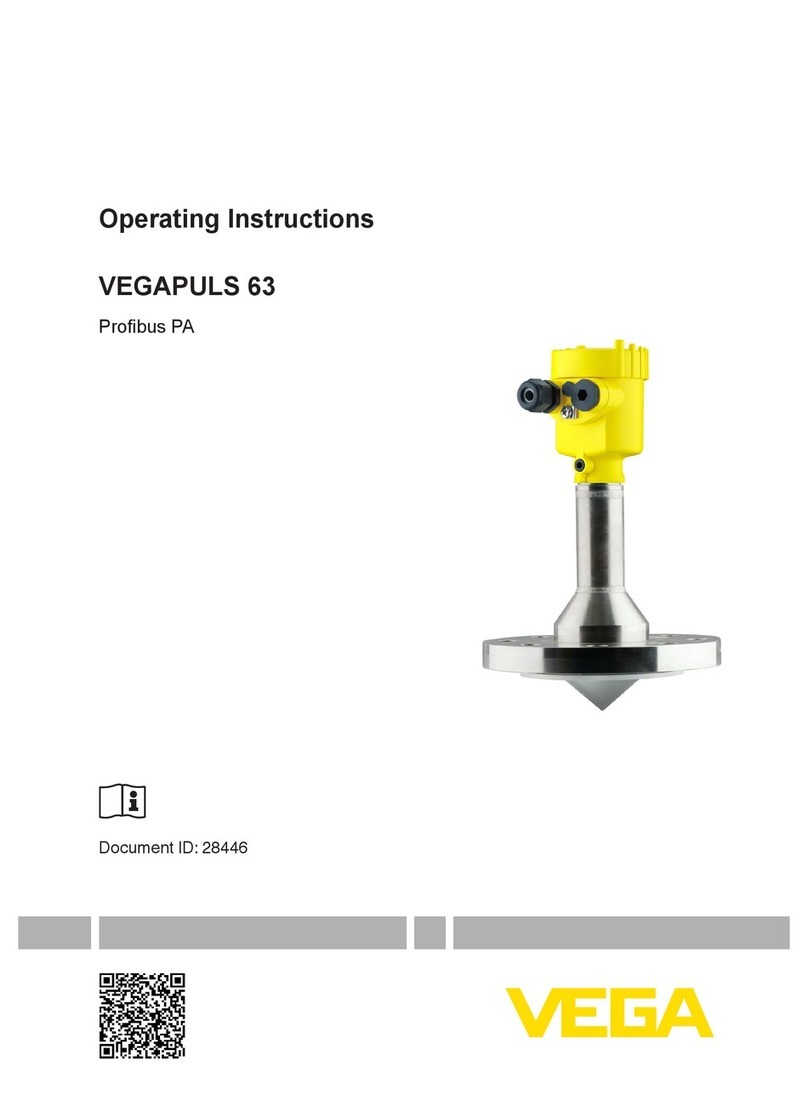
Vega
Vega VEGAPULS 63 User manual
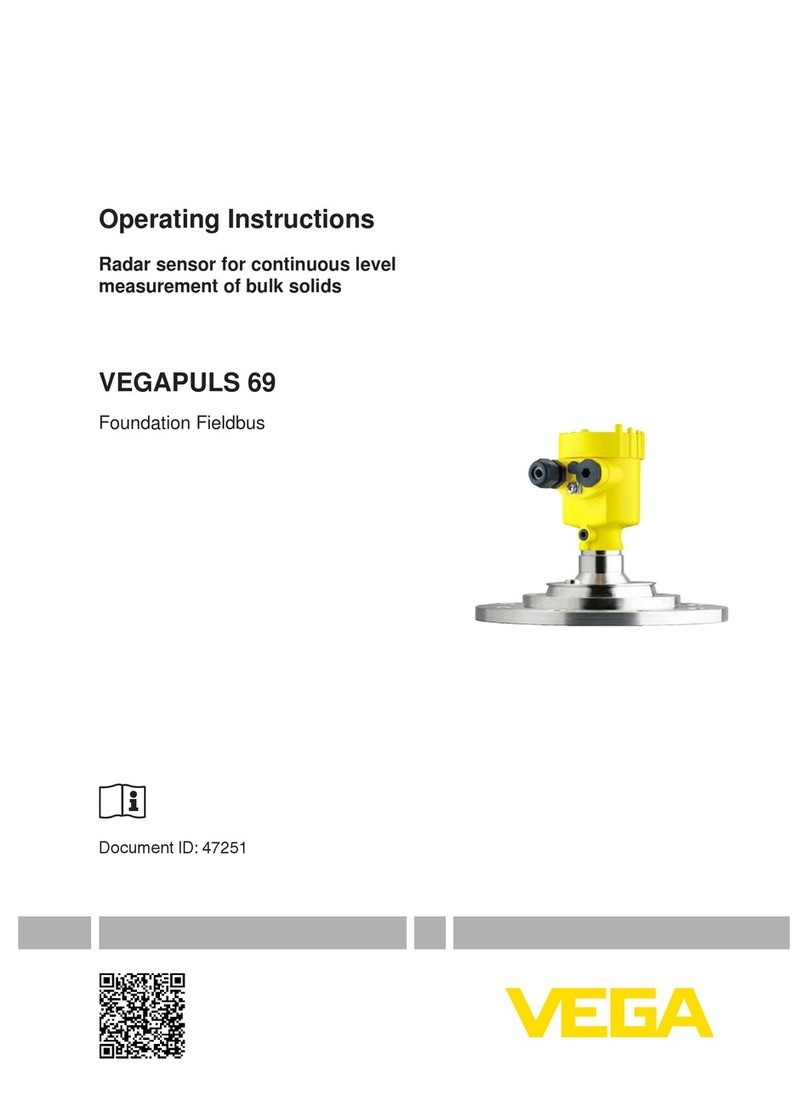
Vega
Vega VEGAPULS 69 User manual

Vega
Vega VEGAFLEX 65 User manual
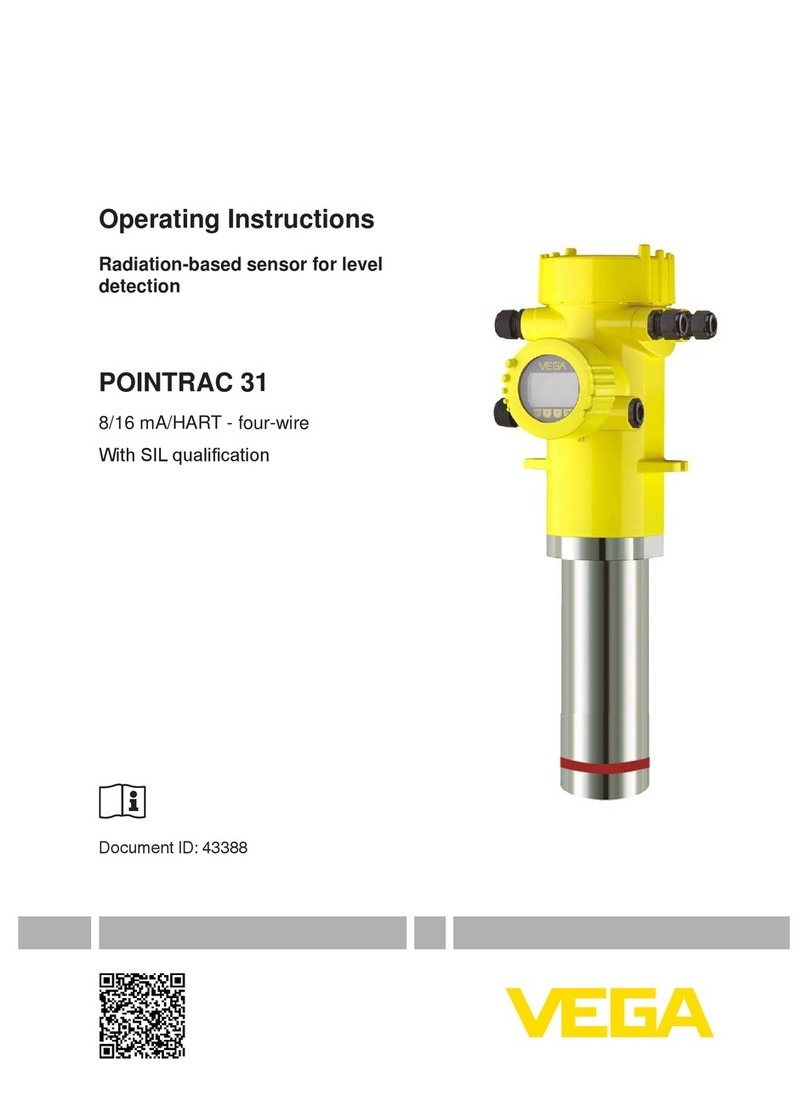
Vega
Vega POINTRAC 31 User manual

Vega
Vega SOLITRAC 31 User manual

Vega
Vega VEGAFLEX 62 User manual

Vega
Vega VEGAPULS 62 User manual
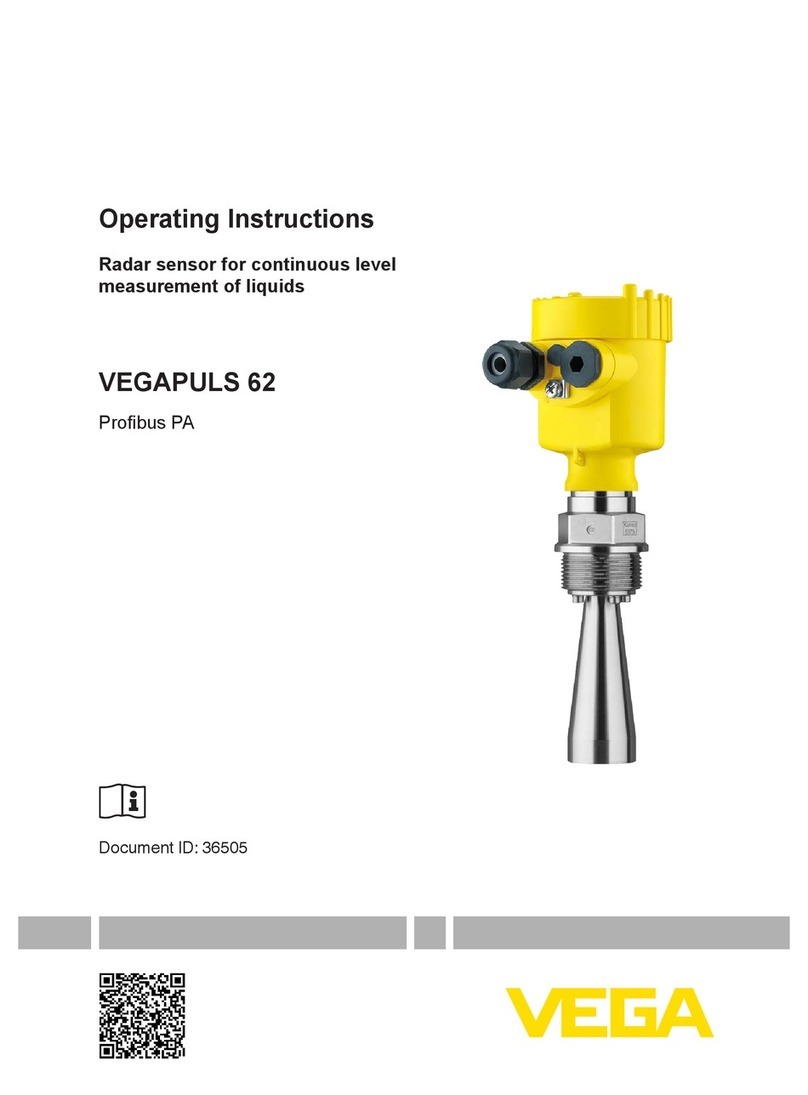
Vega
Vega VEGAPULS 62 User manual
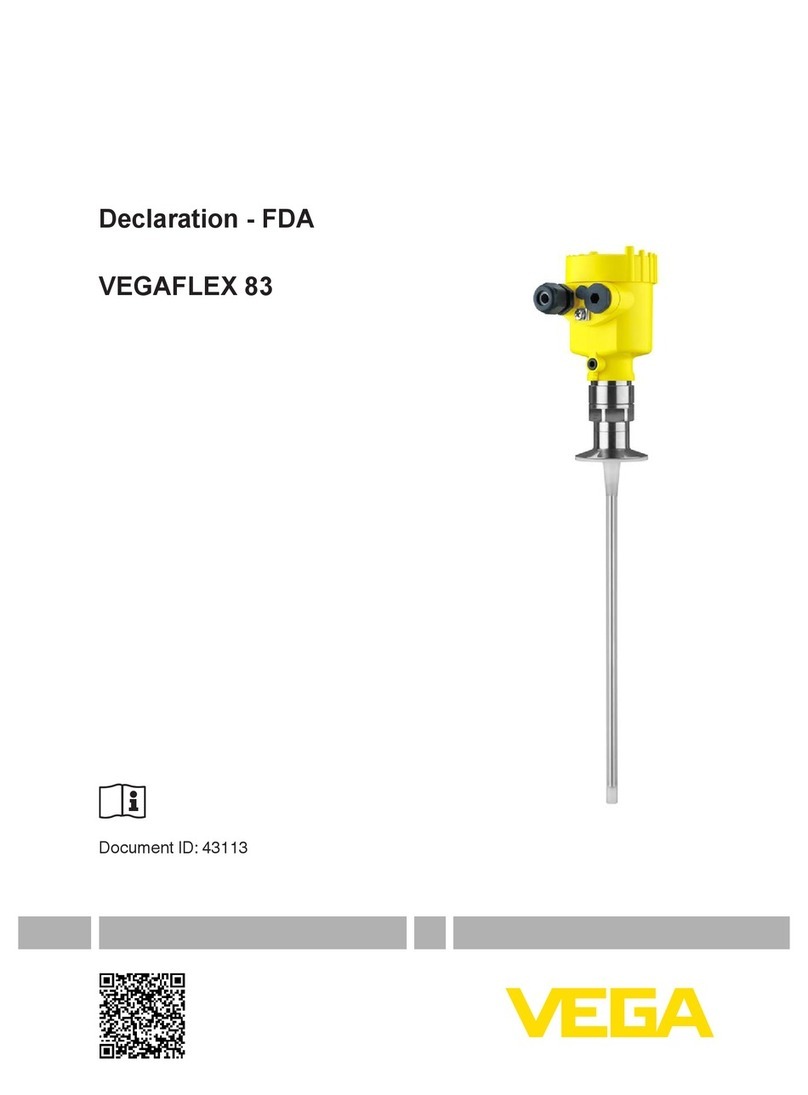
Vega
Vega vegaflex 83 User manual
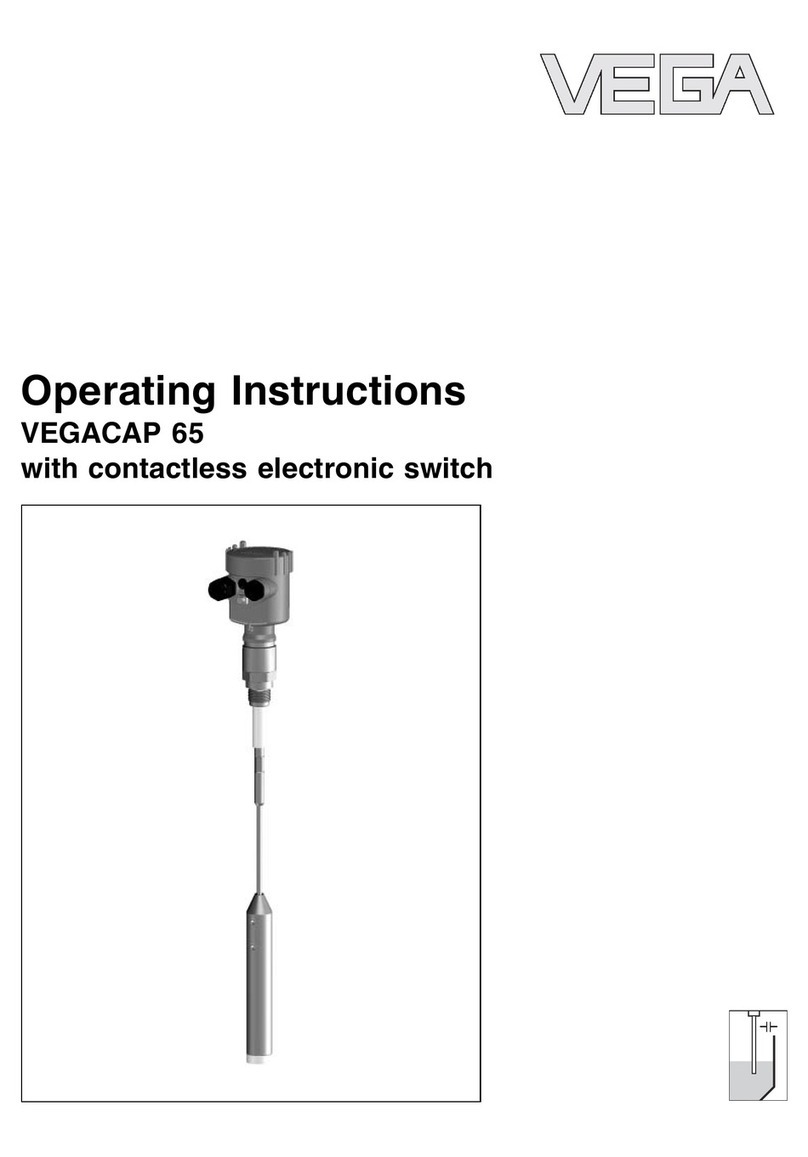
Vega
Vega VEGACAP 65 User manual
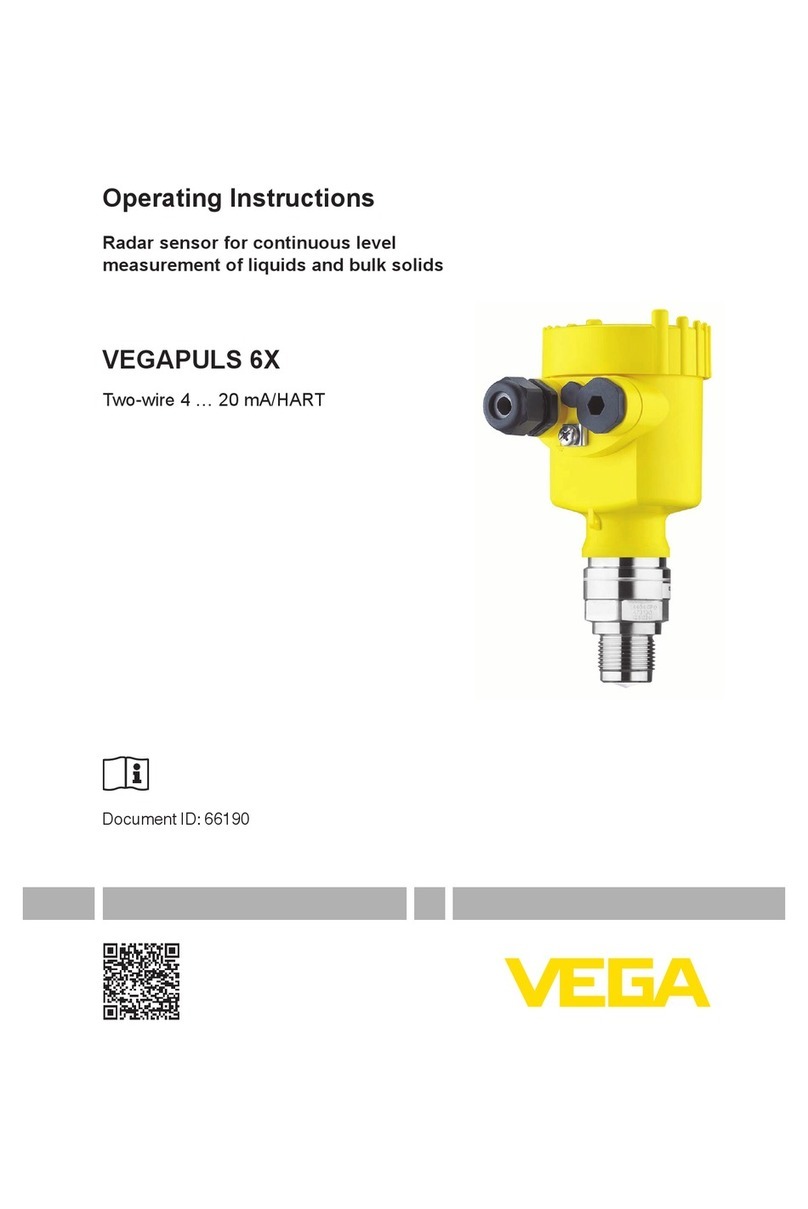
Vega
Vega VEGAPULS 6X User manual
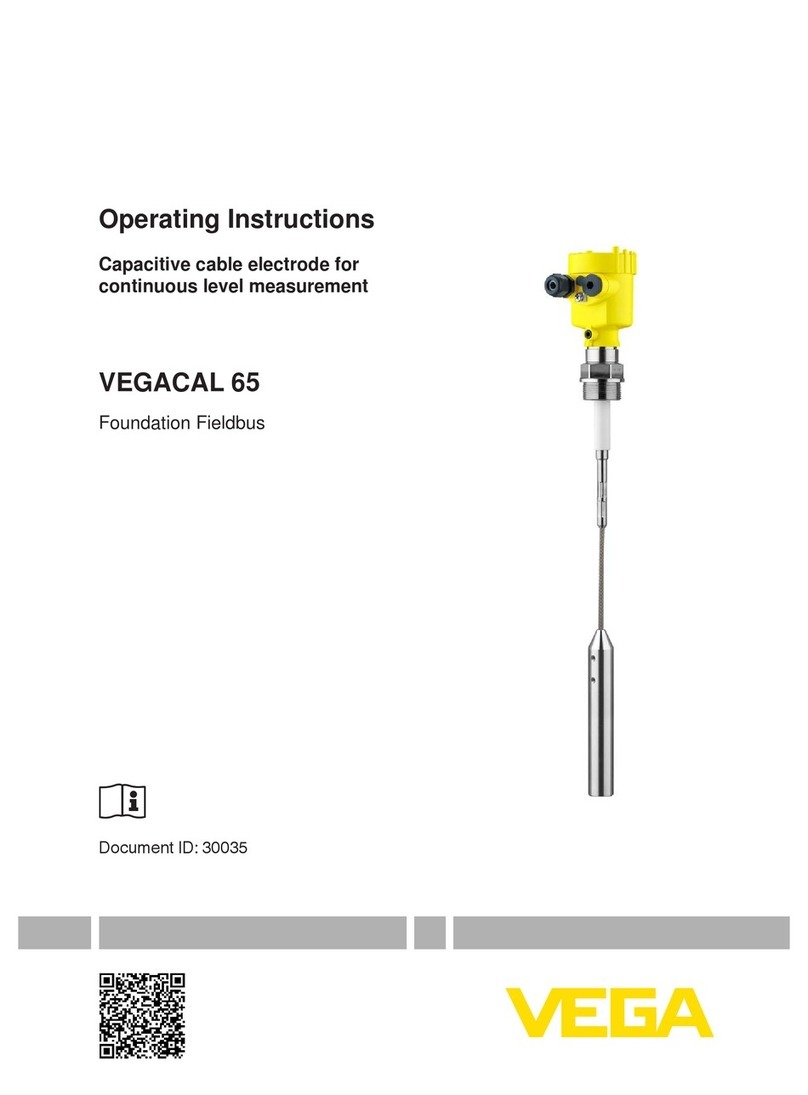
Vega
Vega VEGACAL 65 User manual
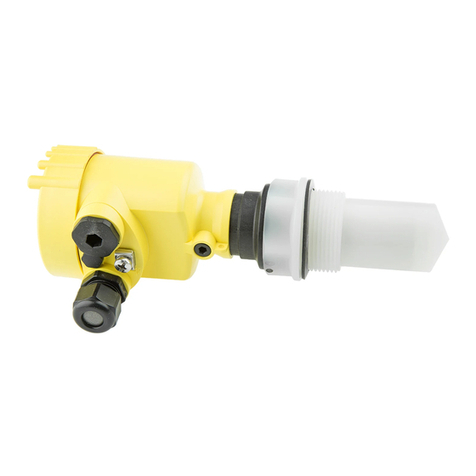
Vega
Vega VEGAPULS 61 User manual
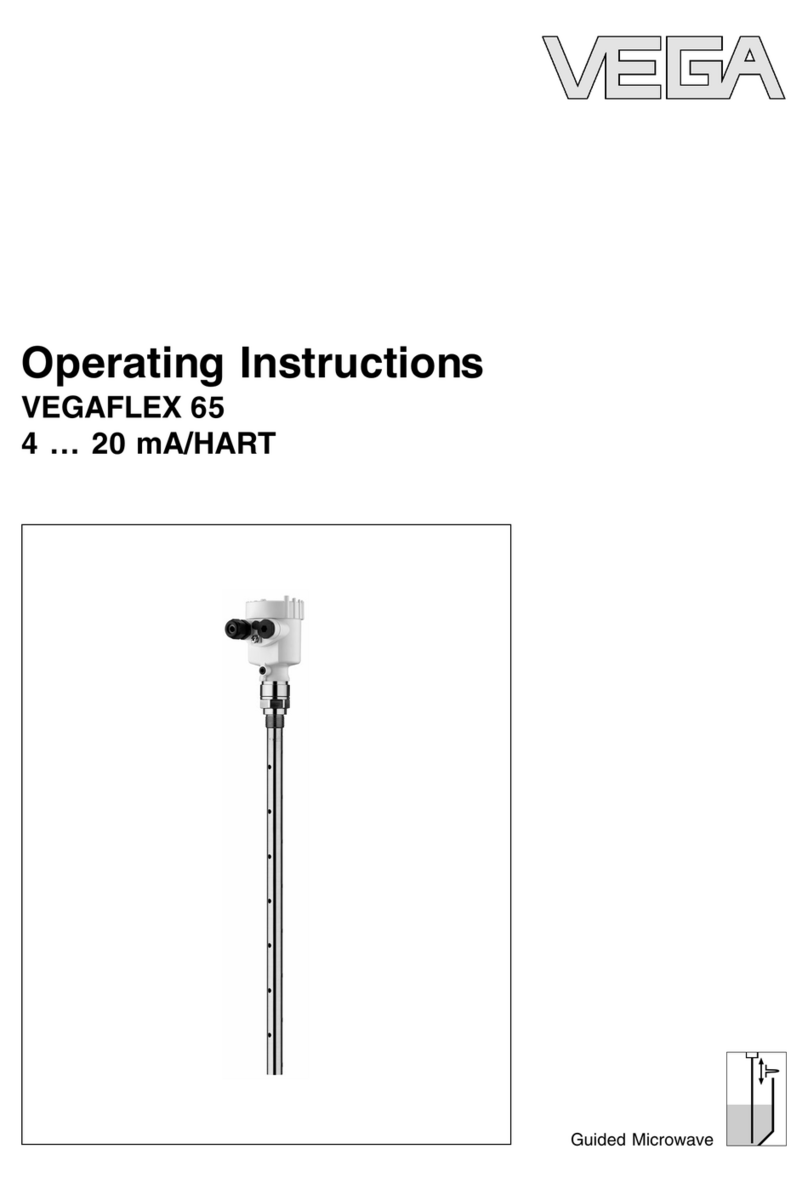
Vega
Vega VEGAFLEX 65 User manual
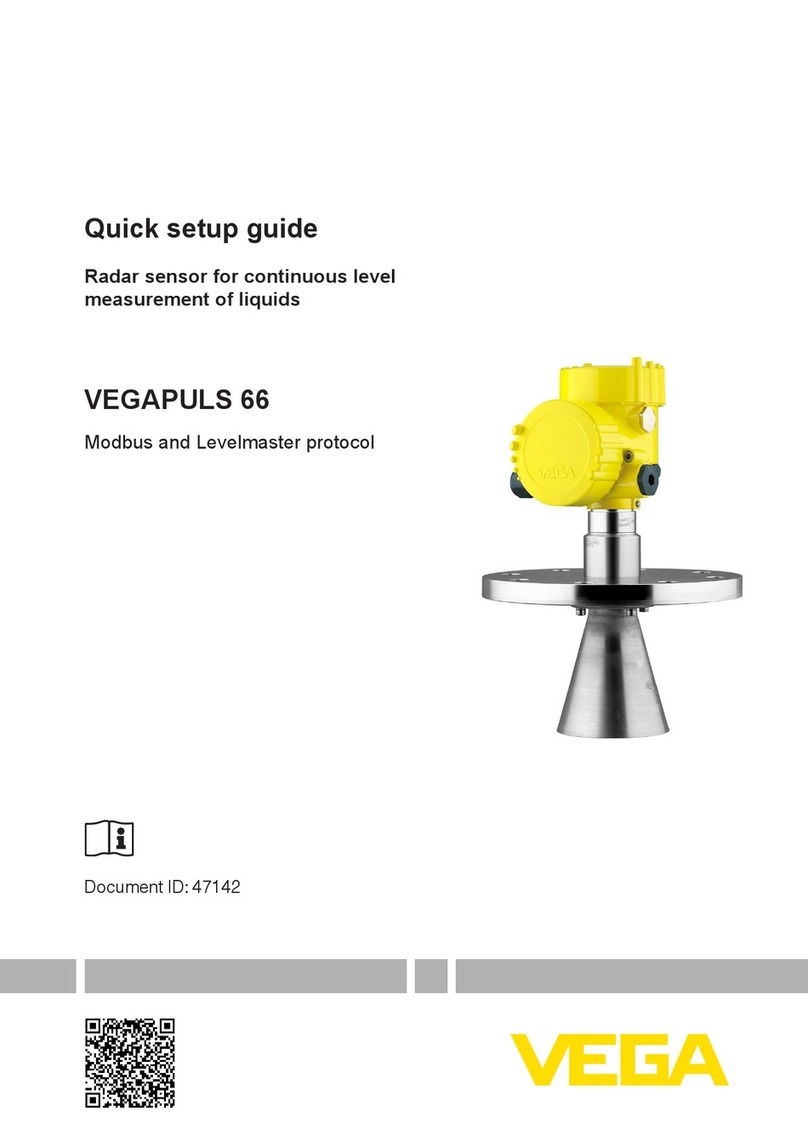
Vega
Vega VEGAPULS 66 User manual
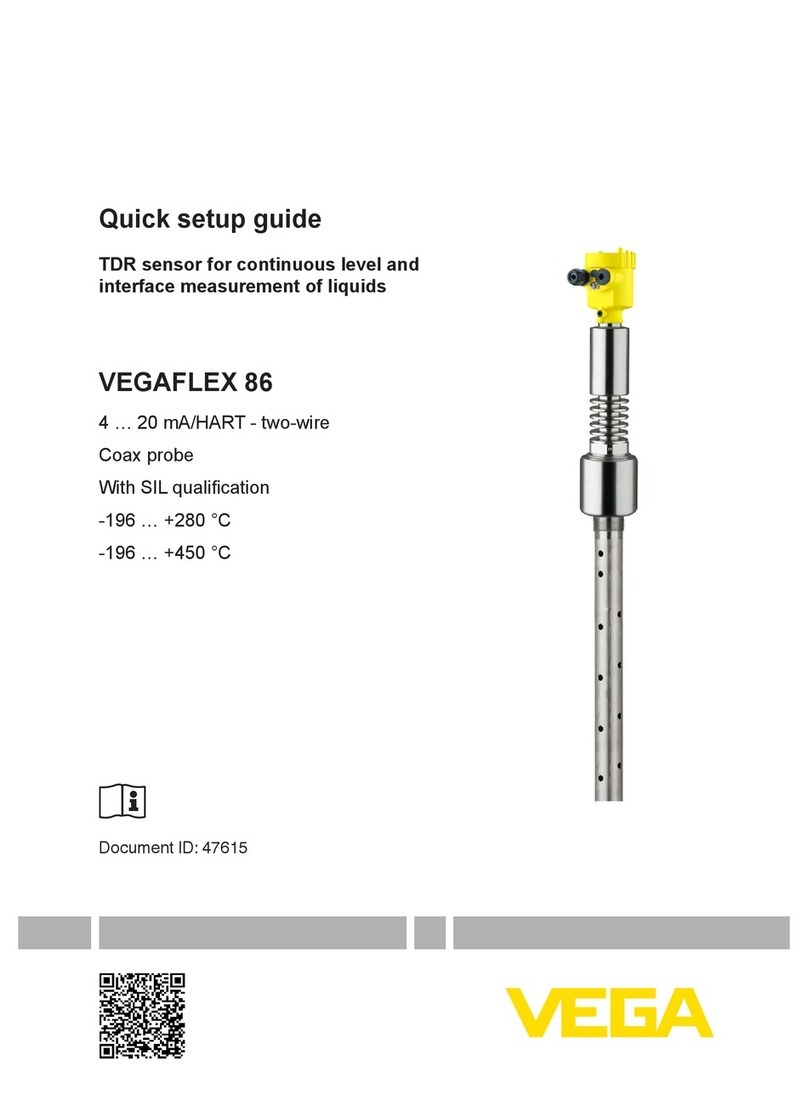
Vega
Vega VEGAFLEX 86 User manual
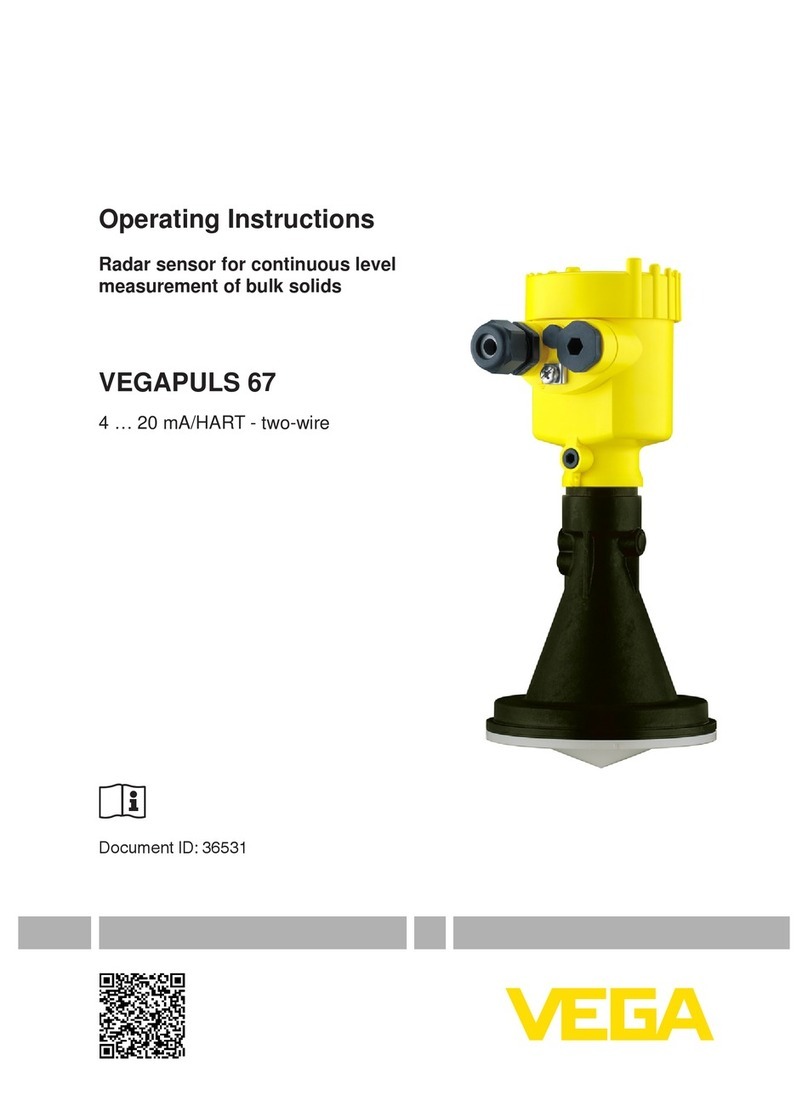
Vega
Vega VEGAPULS 67 User manual

Vega
Vega VEGAPULS 62 User manual
